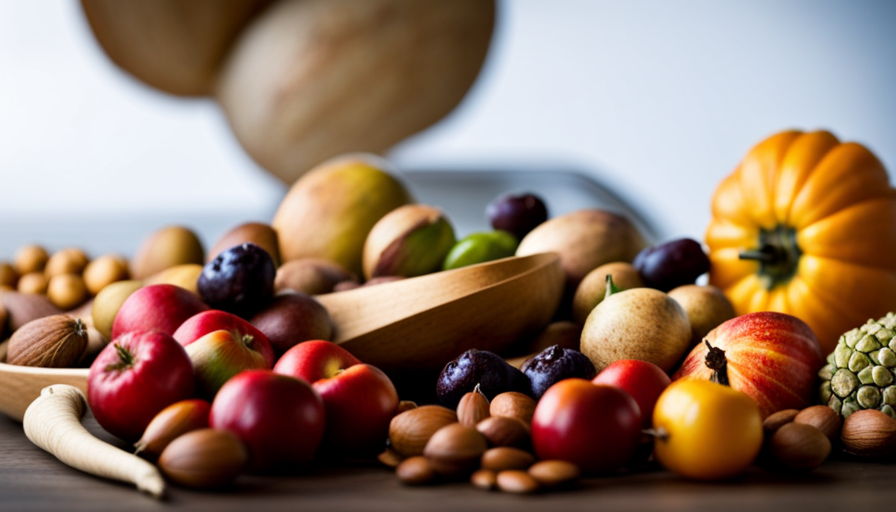Yesterday, I had a discussion with a friend about the definition of raw food. It made me realize that many people are still unclear about what raw food really is. Therefore, I have decided to explore this topic further and share my research findings with you.
When we talk about raw food, we are referring to any food that has not been cooked, processed, or heated above a certain temperature. This includes fruits, vegetables, nuts, seeds, and even certain dairy products and meats.
But why would anyone choose to eat raw food? Well, there are numerous benefits associated with this dietary choice, ranging from increased nutrient intake to improved digestion and weight management.
In this article, we will explore the concept of raw food in depth, discussing its definition, the raw food diet, how to incorporate raw food into your meals, safety considerations, and even the impact of raw food on emotional well-being.
So, let’s jump right in and uncover the fascinating world of raw food.
Key Takeaways
- Raw food refers to food that is not cooked, processed, or heated above a certain temperature.
- Eating raw food can increase nutrient intake, improve digestion, and aid in weight management.
- Raw food is rich in antioxidants, low in calories, and high in fiber, offering numerous nutritional benefits.
- Cooking destroys essential vitamins and enzymes present in raw food, reducing its overall nutritional value.
Definition of Raw Food
So, when you’re talking about raw food, you’re basically referring to food that hasn’t been cooked or processed in any way. The raw food definition is quite simple: it encompasses all fruits, vegetables, nuts, seeds, and grains that are consumed in their natural state, without any heat or chemical treatment.
Raw food enthusiasts argue that cooking can deplete the nutritional value of food, as heat can destroy essential vitamins and enzymes. They believe that consuming raw food provides numerous health benefits, such as increased energy levels, improved digestion, and enhanced immune function. Additionally, raw food is typically rich in fiber and water content, which can aid in weight management and promote a feeling of fullness.
Some studies suggest that incorporating more raw foods into your diet can lead to lower blood pressure, reduced risk of heart disease, and improved overall health. Now, let’s delve into the benefits of raw food without further ado.
Benefits of Raw Food
One major perk of eating raw food is that it’s like a breath of fresh air for your body. Raw food is packed with health benefits and offers a high nutritional value. When food is cooked, it can lose some of its vital nutrients due to heat exposure. However, by consuming raw food, you ensure maximum retention of essential vitamins, minerals, and enzymes that are beneficial for your overall health.
Raw food is known to be rich in antioxidants, which help protect your body against harmful free radicals and reduce the risk of chronic diseases such as heart disease and cancer. Additionally, raw food is often low in calories and high in fiber, making it an excellent choice for weight management and digestion.
Moreover, the nutritional value of raw food is enhanced by the fact that it is not processed or refined. This means that you’re consuming food in its most natural and unadulterated form, providing your body with the nutrients it needs in their purest state.
Transitioning into the subsequent section about the ‘raw food diet,’ it’s important to understand that adopting a raw food diet involves more than just consuming raw food; it entails a specific approach to food preparation and consumption.
Raw Food Diet
A raw food diet is a dietary approach that focuses on consuming uncooked and unprocessed foods. The principles and guidelines of a raw food diet include eating primarily fruits, vegetables, nuts, and seeds, while avoiding cooked, processed, and animal-based foods.
There are different types of raw food diets, such as raw vegan and raw vegetarian, which may vary in terms of the inclusion of certain food groups. However, it’s important to consider potential challenges and considerations of a raw food diet, such as the need for careful meal planning to ensure nutrient adequacy and the risk of foodborne illnesses from consuming raw foods.
Principles and guidelines of a raw food diet
The principles and guidelines of a raw food diet emphasize the consumption of uncooked and unprocessed foods to maximize nutritional value and promote overall health. This type of diet focuses on consuming foods that are in their natural state, without being heated above a certain temperature.
The main principles of a raw food diet include eating a variety of fruits, vegetables, nuts, and seeds, as well as incorporating raw dairy or fermented foods for those who choose to include them. Additionally, it’s important to ensure that the foods consumed are organic and free from chemicals and pesticides.
By following these guidelines, individuals can benefit from the abundance of nutrients found in raw foods.
In the next section, we’ll explore different types of raw food diets, such as raw vegan and raw vegetarian, to further understand the options available for those interested in this lifestyle.
Types of raw food diets (raw vegan, raw vegetarian, etc.)
There are various types of raw food diets, such as raw vegan and raw vegetarian, that offer different options for individuals interested in this lifestyle.
Raw vegan diets consist of uncooked plant-based foods, such as fruits, vegetables, nuts, and seeds. These diets exclude all animal products, including dairy and eggs.
On the other hand, raw vegetarian diets allow for the inclusion of raw dairy products and eggs. Both types of diets focus on consuming natural, unprocessed foods to maximize nutrient intake and promote overall health.
Raw food recipes play a crucial role in these diets, as they provide creative and delicious ways to incorporate raw ingredients into meals.
Transitioning to a raw food diet requires careful planning and education to ensure proper nutrient balance. However, potential challenges and considerations of a raw food diet should not deter individuals from exploring this lifestyle further.
Potential challenges and considerations of a raw food diet
Navigating the potential challenges of a raw food diet can be like climbing Mount Everest without any gear. It requires careful planning and consideration to ensure that all nutritional needs are met. Some of the challenges and health risks associated with a raw food diet include:
-
Nutrient deficiencies: Raw food diets often lack essential nutrients like protein, iron, and vitamin B12, which can lead to deficiencies and health problems.
-
Food safety: Consuming raw foods increases the risk of foodborne illnesses, such as salmonella and E. coli, especially if proper food handling and storage practices aren’t followed.
-
Digestive issues: Raw foods can be harder to digest, leading to bloating, gas, and discomfort.
-
Social limitations: Following a raw food diet can be challenging in social settings, as it may limit your food choices and make it difficult to eat out.
Transitioning into the subsequent section about incorporating raw food into your diet, it’s important to understand the potential challenges and health risks associated with this lifestyle.
Incorporating Raw Food into Your Diet
Incorporating raw food into your diet can bring a burst of vibrant flavors and textures that’ll awaken your taste buds. Raw food recipes are a great way to explore new culinary horizons and embrace a healthier lifestyle.
There are many ways to incorporate raw food into your diet, whether you choose to go fully raw or simply incorporate raw meals into your weekly routine. One of the easiest ways to start incorporating raw food is by adding fresh fruits and vegetables to your meals. You can enjoy a refreshing salad as a side dish or make a delicious smoothie with a variety of raw fruits and leafy greens.
Another option is to replace cooked grains with raw alternatives like sprouted quinoa or cauliflower rice. If you’re feeling more adventurous, you can try making raw food recipes such as zucchini noodles with a creamy avocado sauce or a raw vegan cheesecake made from nuts and dates. These recipes not only taste amazing but also provide your body with essential nutrients.
When incorporating raw food into your diet, it’s important to consider safety and hygiene considerations to avoid any potential foodborne illnesses. Transitioning to a raw food diet should be done gradually, and it’s important to clean and properly store your raw ingredients to prevent contamination.
By incorporating raw food into your diet, you can experience a world of exciting flavors and textures while reaping the numerous health benefits. Now let’s explore the safety and hygiene considerations when incorporating raw food into your diet.
Safety and Hygiene Considerations
Ensuring the safety and hygiene of your ingredients is paramount when including raw food in your diet. Raw food can offer numerous health benefits, but it’s important to take necessary safety measures to avoid any potential risks. Here are three key considerations to keep in mind:
-
Source: It’s vital to choose high-quality ingredients from reputable sources. Look for organic produce and make sure the food has been handled properly throughout the supply chain.
-
Cleaning: Thoroughly wash all fruits and vegetables before consuming them raw. This helps remove any dirt, pesticides, or bacteria present on the surface.
-
Storage: Properly store raw food in the refrigerator to maintain its freshness and prevent bacterial growth. Keep raw meat and seafood separate from other ingredients to avoid cross-contamination.
In addition to safety measures, it’s also important to consider the nutritional value of raw food. Raw fruits and vegetables are rich in vitamins, minerals, and enzymes that can be beneficial for our health. However, some nutrients may be lost during cooking, so incorporating raw food into your diet can help maximize the nutritional benefits.
Moving on to common misconceptions about raw food…
Common Misconceptions about Raw Food
Don’t be fooled by the peeling layers of misconceptions surrounding raw food; let’s shed some light on the truth. Common misconceptions about raw food often lead people to believe that it is unsafe or lacking in nutritional value. However, when prepared and consumed properly, raw food can offer numerous health benefits.
One common misconception is that raw food is more likely to cause foodborne illnesses. While it is true that certain raw foods, such as eggs and meat, can carry harmful bacteria, proper handling and preparation can significantly reduce the risk. Another misconception is that raw food lacks essential nutrients. In reality, raw fruits and vegetables are rich in vitamins, minerals, and antioxidants that are beneficial for our health. Cooking can sometimes destroy some of these nutrients, making raw food a great option for maximizing nutritional intake.
To further illustrate the health benefits of raw food, let’s take a look at the following table:
| Common Misconceptions | Health Benefits |
|---|---|
| Raw food is unsafe | Rich in nutrients and antioxidants |
| Raw food lacks flavor | Promotes weight loss and digestive health |
| Raw food is boring | Boosts immune system and energy levels |
It is important to note that while raw food can provide these benefits, it is not the only way to achieve a healthy diet. Transitioning to a raw food diet should be done gradually and under the guidance of a healthcare professional. Now, let’s explore the relationship between raw food and sustainability.
Raw Food and Sustainability
To truly embrace a sustainable lifestyle, you must consider the impact of your food choices, including the environmental benefits and challenges associated with a raw food diet. Raw food diets have gained popularity in recent years due to their perceived health benefits and connection to sustainability.
By consuming raw, unprocessed foods, individuals believe they are reducing their environmental footprint and promoting a healthier lifestyle. When it comes to sustainability and health, raw food diets have both positive and negative impacts. On one hand, consuming raw foods eliminates the need for energy-intensive cooking methods, reducing greenhouse gas emissions and energy consumption. Additionally, raw food diets often prioritize organic and locally sourced ingredients, further reducing environmental impact.
However, it is important to note that not all raw food options are sustainable. For example, consuming large quantities of imported tropical fruits may have adverse effects on the environment due to transportation emissions. Furthermore, the environmental impact of raw food diets extends beyond the ingredients themselves. The packaging and preservation methods used in raw food diets can also contribute to waste and environmental degradation.
For instance, pre-packaged raw food products often come in single-use plastic containers, which contribute to plastic pollution. Additionally, raw food diets often require specialized equipment, such as dehydrators and blenders, which consume energy and contribute to overall environmental impact.
While raw food diets can have positive sustainability and health impacts, it is crucial to consider the entire lifecycle of the diet, including ingredient sourcing, packaging, and preparation techniques. By making informed choices and incorporating sustainable practices into raw food diets, individuals can minimize their environmental impact while enjoying the benefits of raw, unprocessed foods.
Moving forward, it is important to explore the relationship between raw food and food preparation techniques to gain a comprehensive understanding of sustainable eating practices.
Raw Food and Food Preparation Techniques
Raw food and sustainability go hand in hand, as the consumption of raw food reduces the need for energy-intensive cooking processes and packaging materials. However, it’s important to understand that raw food doesn’t mean unprepared or unprocessed food.
Raw food can still undergo various food preservation techniques and cooking methods that don’t involve heat. Food preservation techniques such as fermentation, pickling, and dehydration can be used to extend the shelf life of raw foods while maintaining their nutritional value. These methods not only preserve the food but also enhance its flavors and textures.
Additionally, there are cooking techniques that can be used with raw food, such as marinating, blending, and sprouting, which can enhance the taste and digestibility of certain foods. By incorporating these preservation and cooking techniques, raw food enthusiasts can enjoy a wide variety of delicious and nutritious meals. These techniques allow for the creation of raw food dishes that are both visually appealing and packed with flavor.
As we transition into the next section about raw food and emotional well-being, it’s important to recognize that the way we prepare and consume our food can have a significant impact on our overall well-being.
Raw Food and Emotional Well-being
Indulging in the vibrant and nourishing world of raw cuisine can truly be a feast for the soul, uplifting our emotional well-being with every bite. Raw food has a positive impact on our mental health and emotional well-being. When we consume raw foods, we’re providing our bodies with essential nutrients, enzymes, and antioxidants that support brain function and promote overall mental wellness.
Raw foods are rich in vitamins, minerals, and phytochemicals that play a crucial role in maintaining emotional balance. For example, leafy greens like kale and spinach are packed with folate, a nutrient that helps produce dopamine and serotonin, neurotransmitters that regulate mood and emotions. Nuts and seeds, commonly found in raw food recipes, are high in omega-3 fatty acids, which have been linked to improved mental health and reduced symptoms of depression.
Additionally, the process of preparing and consuming raw food can have a therapeutic effect on our emotional well-being. Engaging in the creative process of making raw meals can be a form of self-expression and a way to connect with our emotions. The vibrant colors, textures, and flavors of raw food can stimulate our senses and uplift our mood.
Incorporating raw food into our diet can have a profound impact on our emotional well-being and mental health. By nourishing our bodies with nutrient-dense, unprocessed foods, we’re giving ourselves the best chance for optimal emotional and mental well-being.
To learn more about the benefits of raw food and further resources, let’s dive into the next section.
Conclusion and Further Resources
By embracing the vibrant world of raw cuisine, we can nourish our bodies and uplift our emotional well-being with every bite. Raw food has been shown to offer numerous benefits that go beyond physical health. Here are some key takeaways and further resources to explore:
-
Misconceptions: It is important to address common misconceptions surrounding raw food. Some believe that raw food is tasteless or lacks variety. However, with creativity and knowledge, raw food can be flavorful and diverse. Additionally, there is a misconception that raw food is time-consuming to prepare. While some recipes may require more time, many raw dishes can be quick and easy to make.
-
Benefits: Raw food is rich in enzymes, vitamins, and minerals, as it’s not subjected to high heat during cooking. These nutrients support our overall well-being and promote optimal bodily functions. Additionally, raw food is often high in fiber, which aids digestion and supports a healthy gut. Moreover, consuming raw food can increase our intake of antioxidants, which help protect against oxidative stress and inflammation.
-
Conclusion and Further Resources: In conclusion, incorporating raw food into our diet can have a positive impact on our emotional well-being. It provides a variety of health benefits and challenges common misconceptions. To learn more about raw food and explore delicious recipes, resources such as books, websites, and cooking classes can be valuable tools. Some recommended resources include ‘Raw Food/Real World’ by Matthew Kenney and Sarma Melngailis, the website ‘Raw Food Recipes’, and local raw food workshops or retreats.
Remember, by exploring the world of raw cuisine, we can nourish our bodies, uplift our emotional well-being, and discover a whole new realm of culinary delights.
Frequently Asked Questions
Can I eat raw meat or fish as part of a raw food diet?
Yes, you can eat raw meat or fish as part of a raw food diet. The raw food diet consists of consuming uncooked and unprocessed foods, such as fruits, vegetables, nuts, and seeds. By including raw meat or fish in your diet, you can benefit from the high protein content and essential nutrients they provide.
However, it’s important to ensure that the meat or fish is fresh, properly handled, and sourced from trusted suppliers to reduce the risk of foodborne illnesses.
Are there any potential health risks associated with consuming raw food?
There are potential foodborne illnesses associated with consuming raw food. Raw food, including raw meat and fish, can harbor harmful bacteria, such as Salmonella and E. coli, which can cause severe illness. Cooking food properly can help to eliminate these bacteria and reduce the risk of foodborne illnesses.
Additionally, cooking food can enhance its digestibility, increase nutrient availability, and improve overall food safety. Therefore, it’s important to consider the potential health risks and benefits of cooking food before consuming it raw.
Is it possible to get all the necessary nutrients from a raw food diet?
It is possible to get all the necessary nutrients from a raw food diet, but it may have an impact on digestion and lead to potential deficiencies. Raw food diets consist of uncooked, unprocessed foods that are rich in vitamins, minerals, and enzymes. However, cooking can enhance the availability and absorption of certain nutrients.
Additionally, a raw food diet may lack certain essential nutrients, such as vitamin B12, iron, and omega-3 fatty acids, which could potentially lead to deficiencies if not carefully balanced.
Can children and pregnant women follow a raw food diet safely?
Children and pregnant women on a raw food diet, is it safe? It is important to consider the potential risks and benefits of a raw food diet for these specific groups.
While a raw food diet can provide an abundance of vitamins, minerals, and enzymes, it may also increase the risk of nutrient deficiencies and foodborne illnesses.
Children and pregnant women have unique nutritional needs, and a raw food diet may not provide adequate nutrients for proper growth and development. It’s recommended to consult with a healthcare professional before considering a raw food diet for these individuals.
How can I ensure food safety when preparing and storing raw food at home?
To ensure food safety when preparing and storing raw food at home, it’s crucial to follow proper preparation techniques. This includes washing hands thoroughly before handling food, cleaning all surfaces and utensils, and separating raw foods from cooked ones to prevent cross-contamination.
Additionally, storing raw food at the correct temperature, either in the refrigerator or freezer, helps to minimize the growth of harmful bacteria. Following these practices promotes food safety and reduces the risk of foodborne illnesses.
Does Raw Food Always Mean Uncooked?
Yes, the raw food definition clarified. While raw food is typically uncooked, some raw food enthusiasts also include foods cooked at very low temperatures to preserve nutrients. So, raw doesn’t always mean uncooked. It’s more about preserving the food’s natural state and nutrients through minimal processing.
Conclusion
In conclusion, raw food refers to food that’s uncooked, unprocessed, and free from additives or preservatives. Incorporating raw food into your diet can have numerous health benefits, including increased nutrient intake and improved digestion. Interestingly, a study conducted by the University of California found that cooking food can result in a loss of up to 50% of certain nutrients. Therefore, opting for raw food can help ensure you’re getting the maximum nutritional value from your meals.
For more information and resources on raw food, consult reputable sources like scientific journals and registered dietitians.










